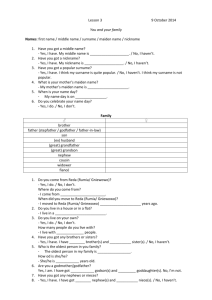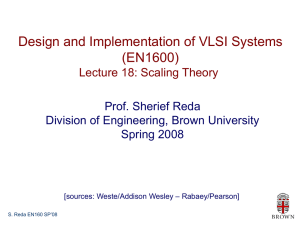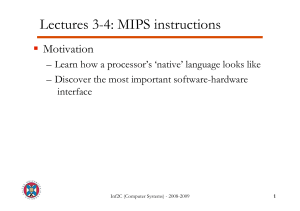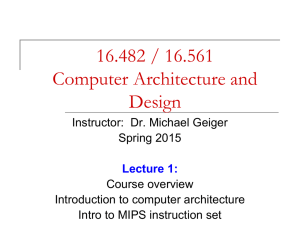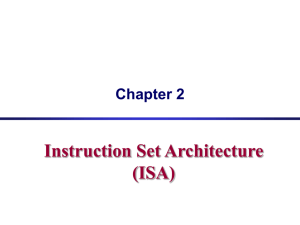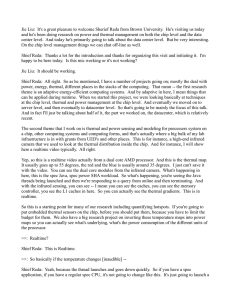ISA 2 - Brown University
advertisement
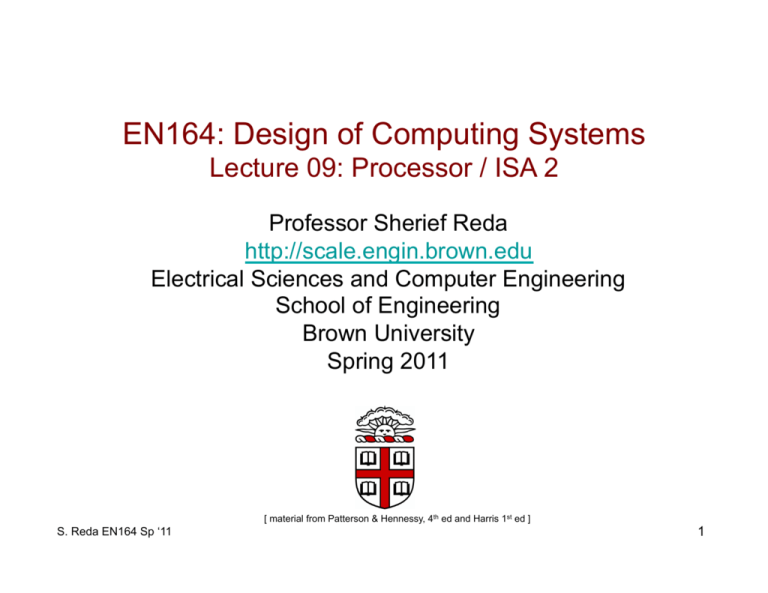
EN164: Design of Computing Systems Lecture 09: Processor / ISA 2 Professor Sherief Reda http://scale.engin.brown.edu Electrical Sciences and Computer Engineering School of Engineering Brown University Spring 2011 [ material from Patterson & Hennessy, 4th ed and Harris 1st ed ] S. Reda EN164 Sp ‘11 1 MIPS architecture • Used as the example throughout the course • Stanford MIPS commercialized by MIPS Technologies (www.mips.com) • Large share of embedded core market – Applications in consumer electronics, network/storage equipment, cameras, printers, … • Typical of many modern ISAs • 32 bit and 64 bit available • Will implement and boot a subset MIPS processor in lab S. Reda EN164 Sp ‘11 2 Arithmetic operations High-level code MIPS assembly code a = b + c; a = b - c; # $s0 = a, $s1 = b, $s2 = c add $s0, $s1, $s2 sub $s0, $s1, $s2 • add: mnemonic indicates what operation to perform • $s1, $s1: source operands on which the operation is performed • $s0: destination operand to which the result is written Design Principle 1: Simplicity favors regularity Regularity makes implementation simpler Simplicity enables higher performance at lower cost S. Reda EN164 Sp ‘11 3 Register operands • • • Memory is slow. Most architectures have a small set of (fast) registers MIPS has a 32 32-bit register file Assembler names Use for frequently accessed data Numbered 0 to 31 32-bit data called a “word” Written with a $ before their name $0 always hold value 0 $t0, $t1, …, $t9 for temporary values $s0, $s1, …, $s7 for saved variables Design Principle 2: Smaller is faster c.f. main memory: millions of locations S. Reda EN164 Sp ‘11 4 MIPS registers Name Register Number Usage $0 0 the constant value 0 $at 1 assembler temporary $v0-$v1 2-3 procedure return values $a0-$a3 4-7 procedure arguments $t0-$t7 8-15 temporaries $s0-$s7 16-23 saved variables $t8-$t9 24-25 more temporaries $k0-$k1 26-27 OS temporaries $gp 28 global pointer $sp 29 stack pointer $fp 30 frame pointer $ra 31 procedure return address S. Reda EN164 Sp ‘11 5 Format of R-type instructions • • Register-type 3 register operands: – rs, rt: source registers – rd: destination register • Other fields: – op: the operation code or opcode (0 for R-type instructions) – funct: the function together, the opcode and function tell the computer what operation to perform – shamt: the shift amount for shift instructions, otherwise it’s 0 S. Reda EN164 Sp ‘11 6 R-Type examples Note the order of registers in the assembly code: add rd, rs, rt S. Reda EN164 Sp ‘11 7 Memory operands • Too much data to fit in only 32 registers • Memory is large, but slow • Commonly used variables kept in registers • Using a combination of registers and memory, a program can access a large amount of data fairly quickly • To apply arithmetic operations Load values from memory into registers Store result from register to memory S. Reda EN164 Sp ‘11 8 Word-addressable memory • Each 32-bit data word has a unique address S. Reda EN164 Sp ‘11 9 Reading word-addressable memory • • • • Memory reads are called loads Mnemonic: load word (lw) Example: read a word of data at memory address 1 into $s3 Memory address calculation: – – • • add the base address ($0) to the offset (1) address = ($0 + 1) = 1 Any register may be used to store the base address. $s3 holds the value 0xF2F1AC07 after the instruction completes. Assembly code lw $s3, 1($0) S. Reda EN164 Sp ‘11 # read memory word 1 into $s3 10 Writing word-addressable memory • • • • • Memory writes are called stores Mnemonic: store word (sw) Example: Write (store) the value held in $t4 into memory address 7 Offset can be written in decimal (default) or hexadecimal Memory address calculation: – – • add the base address ($0) to the offset (0x7) address: ($0 + 0x7) = 7 Any register may be used to store the base address Assembly code sw $t4, 0x7($0) S. Reda EN164 Sp ‘11 # write the value in $t4 # to memory word 7 11 Byte-addressable memory • • • Each data byte has a unique address Load/store words or single bytes: load byte (lb) and store byte (sb) Each 32-bit words has 4 bytes, so the word address increments by 4 S. Reda EN164 Sp ‘11 12 Reading byte-addressable memory • The address of a memory word must now be multiplied by 4. For example, – – the address of memory word 2 is 2 × 4 = 8 the address of memory word 10 is 10 × 4 = 40 (0x28) • • • Load a word of data at memory address 4 into $s3. $s3 holds the value 0xF2F1AC07 after the instruction completes. MIPS is byte-addressed, not word-addressed. Though in our lab implementation, we can modify it to be word-addressed by customizing the RAM memory blocks MIPS assembly code lw $s3, 4($0) S. Reda EN164 Sp ‘11 # read word at address 4 into $s3 13 Writing byte-addressed memory • Example: stores the value held in $t7 into memory address 0x2C (44) MIPS assembly code sw $t7, 44($0) S. Reda EN164 Sp ‘11 # write $t7 into address 44 14 Big-Endian and little-Endian • • • • How to number bytes within a word? Word address is the same for big- or little-endian Little-endian: byte numbers start at the little (least significant) end Big-endian: byte numbers start at the big (most significant) end S. Reda EN164 Sp ‘11 15 Big- and little- Endian example • Suppose $t0 initially contains 0x23456789. After the following program is run on a big-endian system, what value does $s0 contain? In a little-endian system? sw $t0, 0($0) lb $s0, 1($0) • • Big-endian: 0x00000045 Little-endian: 0x00000067 S. Reda EN164 Sp ‘11 16 Design principle 4 in action Good design demands good compromises - Multiple instruction formats allow flexibility - add, sub: use 3 register operands - lw, sw: use 2 register operands and a constant - Number of instruction formats kept small - to adhere to design principles 1 and 3 (simplicity favors regularity and smaller is faster). S. Reda EN164 Sp ‘11 17 Constant/Immediate operands • lw and sw illustrate the use of constants or immediates • Called immediates because they are immediately available from the instruction • Immediates don’t require a register or memory access. • The add immediate (addi) instruction adds an immediate to a variable (held in a register). • An immediate is a 16-bit two’s complement number. • Is subtract immediate (subi) necessary? High-level code MIPS assembly code a = a + 4; b = a – 12; # $s0 = a, $s1 = b addi $s0, $s0, 4 addi $s1, $s0, -12 S. Reda EN164 Sp ‘11 18 I-Type format instructions • • Immediate-type 3 operands: – rs, rt: register operands – imm: 16-bit two’s complement immediate • Other fields: – op: the opcode – Simplicity favors regularity: all instructions have opcode – Operation is completely determined by the opcode S. Reda EN164 Sp ‘11 19 I-Type examples Note the differing order of registers in the assembly and machine codes: addi rt, rs, imm lw rt, imm(rs) sw rt, imm(rs) S. Reda EN164 Sp ‘11 20
